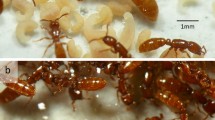Summary
The present paper describes for the first time that adult-to-adult trophallaxis exists in ponerine ants. Furthermore, it shows that the adult castes of the ponerine andHypoponera sp. have different habits of trophallaxis. Workers display a soliciting behavior toward queens, males and workers, but receive regurgitated food only from workers. The workers are forced to stop soliciting for regurgitated food by the “whipping behavior” of the queen. Callow queens solicit regurgitated food from workers and ergatoid males and receive it, while mature queens do not solicit regurgitation from workers. Ergatoid males receive regurgitated food from workers and regurgitate it to queens. Alate males show no trophallactic food exchange with workers and queens. Trophallactic behavior was never observed between males of either winged or ergatoid types.
Similar content being viewed by others
References
Baroni Urbani, C., B. Bolton and P. H. Ward, 1992. The internal phylogeny of ants (Hymenoptera: Formicidae).Syst. Entomol. 17:301–329.
Boomsma, J. J. and J. A. Isaaks, 1985. Energy investment and respiration in queens and males ofLasius niger (Hymenoptera: Formicidae).Behav. Ecol. Sociobiol. 18:19–27.
Eisner, T., 1957. A comparative morphological study of the proventriculus of ants (Hymenoptera: Formicidae).Bulletin of the Museum of Comparative Zoology, Harvard 116:439–490.
Kinomura, K. and K. Yamauchi, 1987. Fighting and mating behaviors of dimorphic males in the antCardiocondyla wroughtoni.J. Ethol. 5:75–81.
Hamilton, W. D., 1979. Wingless and fighting males in fig wasps and other insects. In: Sexual selection and reproductive competition in insects (M. S. Blum and N. A. Blum, Eds.), Academic Press, New York, pp. 167–220.
Hashimoto, Y., 1991. Phylogenetic study of the family Formicidae based on the sensillum structures on the antennae and labial palpi (Hymenoptera, Aculeata).Jap. J. Entomology 59:125–140.
Hölldobler, B., 1985. Liquid food transmission and antennation signals in ponerine ants.Isr. J. Entomology 19:89–99.
Hölldobler, B. and E. O. Wilson, 1990. The Ants. Belknap Press of Harvard University Press, Cambridge, Mass. 732 pp.
Terayama, M., 1992. Structure of ant communities in east Asia I. Regional differences and species richness.Bull. Biogeogr. Soc. Japan 47:1–31.
Villet, M. H., S. A. Hanrahan and C. Walther, 1990. Larval structures associated with larva-to-adult trophallaxis inPlatythyrea (Hymenoptera: Formicidae).Int. J. Insect. Morphol. Embryol. 5:243–256.
Wilson, E. O., 1971. The insect societies. Belknap Press of Harvard University Press, Cambridge, Mass., 548 pp.
Author information
Authors and Affiliations
Rights and permissions
About this article
Cite this article
Hashimoto, Y., Yamauchi, K. & Hasegawa, E. Unique habits of stomodeal trophallaxis in the ponerine antHypoponera sp. . Ins. Soc 42, 137–144 (1995). https://doi.org/10.1007/BF01242450
Received:
Revised:
Accepted:
Issue Date:
DOI: https://doi.org/10.1007/BF01242450




